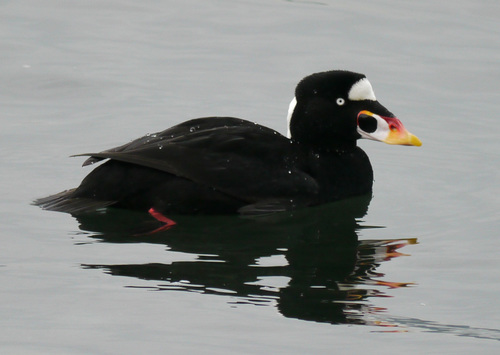
Surf Scoter
The Surf Scoter (Melanitta perspicillata) is a large sea duck known for its distinctive appearance and behavior. It plays a crucial role in coastal ecosystems as a predator of benthic invertebrates. This species is particularly notable for its striking sexual dimorphism, with males displaying bold black and white plumage and a uniquely shaped, colorful bill. While not holding any major specific cultural significance, it is a valued species among birdwatchers and contributes to the biodiversity of North American coastal regions.
43-54 cm
Length
76-91 cm
Wingspan
Least Concern
Conservation Status
Distribution
Breeds in northern North America (Alaska and Canada). Winters along the Pacific and Atlantic coasts of North America, ranging from Alaska to Baja California on the west coast, and from Labrador to Florida on the east coast. Some migration occurs over inland waterways.
Lifespan
Up to 11 years recorded in the wild, but the average lifespan is likely shorter.
Surf Scoter's Habitat
Habitat Types
Coastal waters, Bays, Estuaries, Large inland lakes (during migration)
Climate Zones
Boreal, Temperate, Subarctic
Adaptations
Dense plumage provides insulation in cold waters. Specialized salt glands above the eyes allow them to excrete excess salt, enabling them to drink seawater.
Variations
No recognized subspecies.
Appearance
Breeding Plumage
Adult males in breeding plumage are almost entirely black, with white patches on the forehead and nape. Non-breeding males (eclipse plumage) are duller. Females are dark brown with paler patches on the head.
Seasonal Feather Changes
Males undergo a complete molt after breeding, acquiring the eclipse plumage. Females have less distinct seasonal changes.
Sex Based Plumage Differences
Highly pronounced. Males are black with white patches, while females are brown.
Notable Features
Large, swollen bill with distinctive coloration in males (orange, yellow, black, and white), White patches on the forehead and nape (males), Dark brown plumage with pale head patches (females)
Diet and Feeding
Primary Foods
Mollusks (especially mussels and clams), Crustaceans, Aquatic insects, Small fish, Echinoderms
Foraging Behavior
Dives underwater to forage on the seabed, using its strong bill to pry shellfish loose. Often feeds in large flocks.
Specializations
Strong, heavy bill adapted for crushing shells. Feet positioned far back on the body for efficient diving.
Seasonal Diet Variations
Diet may shift slightly depending on prey availability in different locations and seasons. May consume more plant matter during migration.
Behavior
Social Structure
Highly gregarious, especially during migration and winter, forming large flocks. Less social during the breeding season.
Communication
Soft crooning calls during courtship, Grunts and whistles during social interactions, Alarm calls when threatened
Migration
Migrates long distances between breeding and wintering grounds. Often flies in large, linear formations. Migratory routes follow coastlines, but some birds cross large bodies of water or land.
Territorial or Group Behaviors
Not strongly territorial during the breeding season, but males may defend a small area around the female. Forms large, dense flocks on wintering grounds, often associating with other sea duck species.
Conservation
Threats
Habitat degradation (pollution, coastal development), Oil spills, Entanglement in fishing gear, Climate change (affecting prey availability and breeding habitat), Over-harvesting of shellfish
Protection Programs
Monitoring of populations, Efforts to reduce oil spill risks, Regulations on fishing gear to minimize bycatch
Local National Laws
Protected under the Migratory Bird Treaty Act in the United States and Canada.
Population Trend
Decreasing
Population Estimates
Estimated global population is between 530,000 and 550,000 individuals.
Interesting Facts
They are expert divers.
Surf Scoters can dive up to 20 meters (65 feet) to reach their prey on the seabed.
The male's bill is unique.
The colorful, swollen bill of the male Surf Scoter is one of its most distinguishing features, and its shape and coloration are unique among North American ducks.
They form large flocks.
During winter, Surf Scoters can gather in flocks of thousands of individuals, creating impressive spectacles along coastlines.
Faqs about Surf Scoter
What do Surf Scoters eat?
Surf Scoters primarily eat mollusks (like mussels and clams), crustaceans, and other aquatic invertebrates. They dive underwater to find their food.
Where can I see Surf Scoters?
Surf Scoters can be seen along the Pacific and Atlantic coasts of North America during the winter. Look for them in bays, estuaries, and coastal waters.
Are Surf Scoters endangered?
Surf Scoters are currently listed as Least Concern by the IUCN, but their populations are declining due to various threats.
How deep can Surf Scoter dive?
They are known to dive as deep as 20 meters, though they commonly feed in shallower waters.
Copyright @ Nature Style Limited. All Rights Reserved.
 English
English